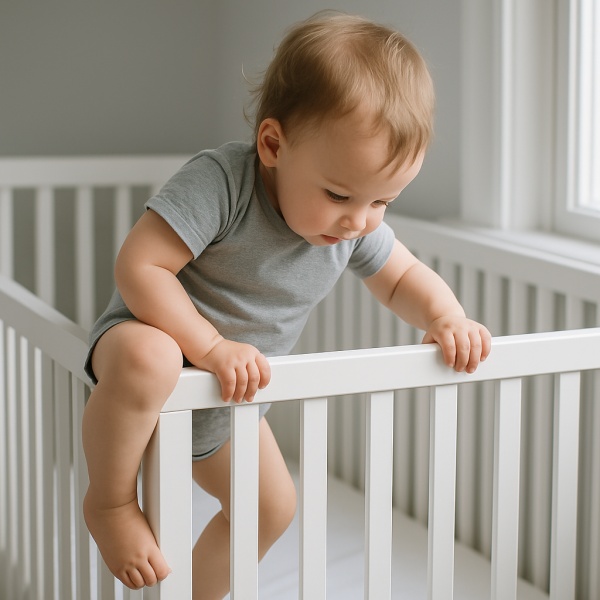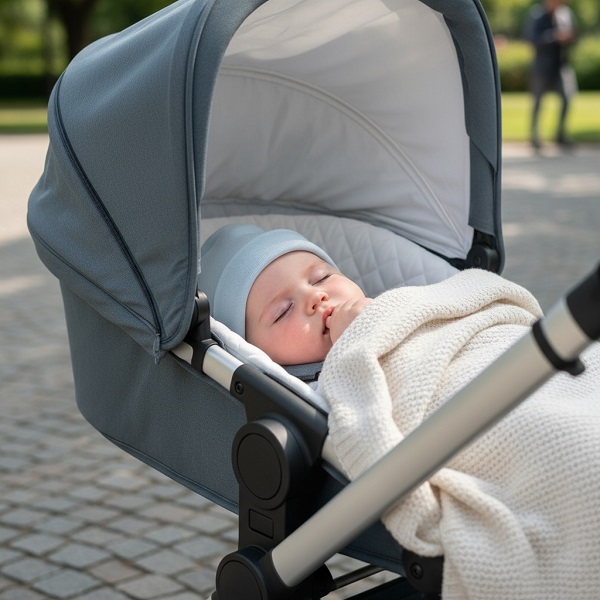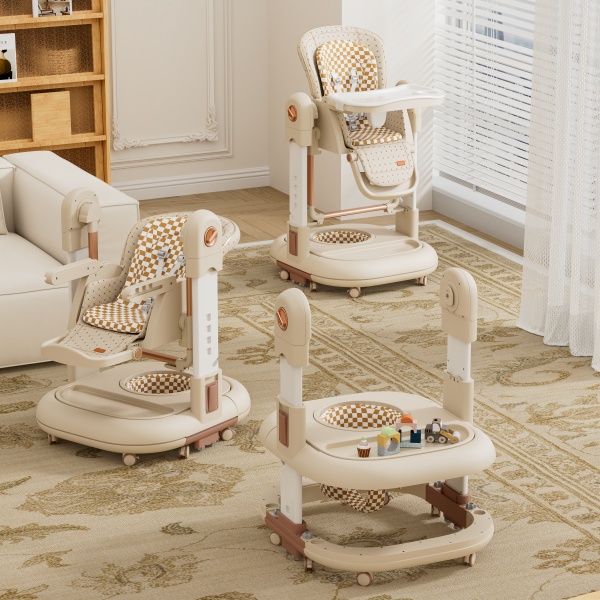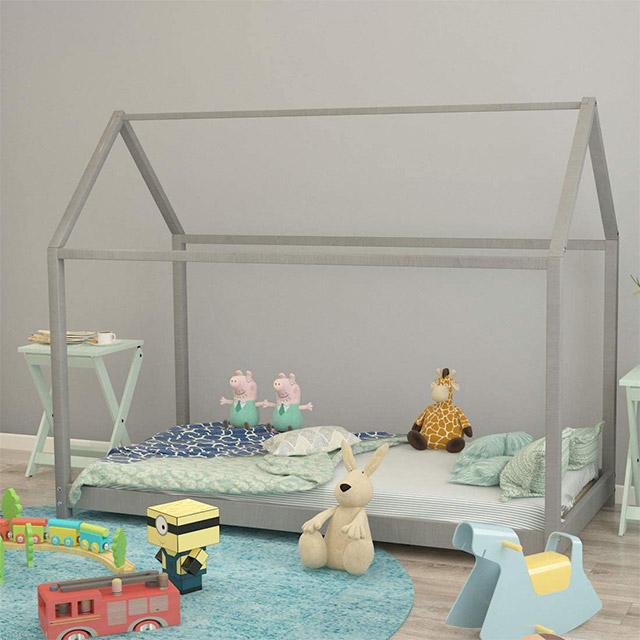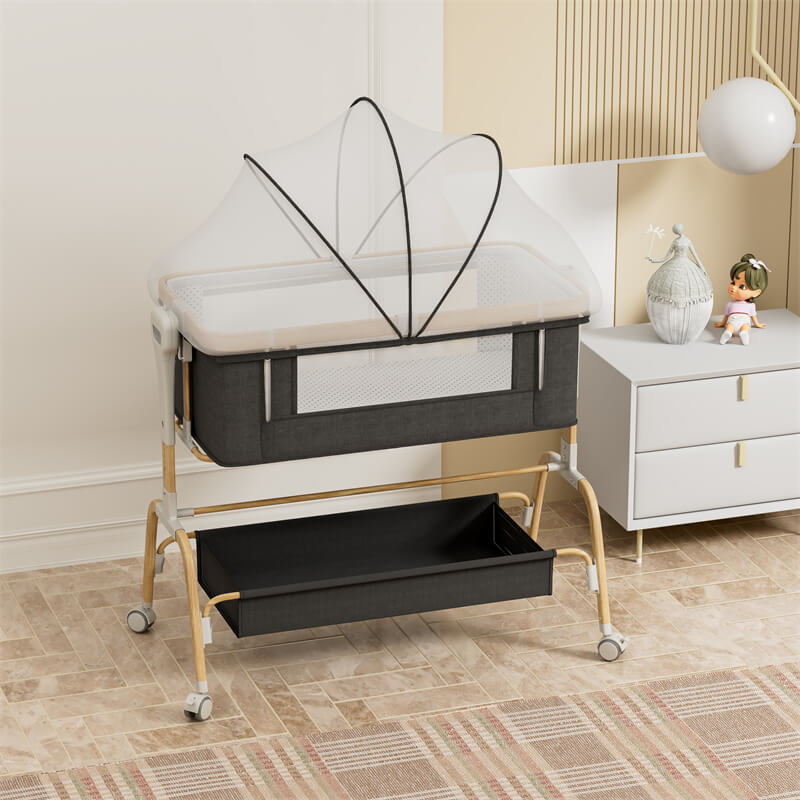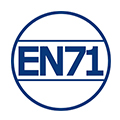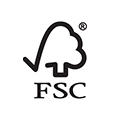Your baby will spend more time sleeping than doing anything else in their first few months, making the crib their primary environment. This small space is more than just a piece of furniture; it is their personal haven for rest, growth, and development.
We know that new parenthood comes with a long list of things to learn, and crib safety guidelines can sometimes feel overwhelming. You might be wondering about the right mattress, what bedding is okay, or how to tell if a crib is truly safe. It’s completely normal to have these questions.
This guide is here to walk you through it all, step-by-step. Think of it as a friendly, helpful checklist designed to turn uncertainty into confidence.
Why is Crib Safety So Critical?
The primary reason we focus so intently on crib safety is to significantly reduce the risk of Sudden Infant Death Syndrome (SIDS) and other sleep-related incidents, such as suffocation or entrapment. It sounds scary, and it’s a topic we approach with care, but the most powerful tool we have is knowledge.
Major health organizations, like the American Academy of Pediatrics (AAP), have dedicated decades of research to understanding these risks. Their recommendations—which we’ll explore in this checklist—aren’t arbitrary rules; they are evidence-based, life-saving measures that have already contributed to a dramatic decrease in sleep-related infant deaths.
Think of it this way: your baby’s crib is their first little home. In these early months, they are learning about the world but are completely reliant on you to make that world safe.
They can’t roll away from a loose blanket or adjust a soft mattress. By carefully curating their sleep space, you are doing the most important job—giving them a secure foundation for peaceful and safe rest. This isn’t about fear; it’s about empowerment.
Every item you check off this list is a positive step toward your baby’s well-being and your own peace of mind.
Is Your Crib Up to Modern Safety Standards?

This might be the most important question you ask, especially if you’re considering a hand-me-down or a second-hand find. While older cribs often carry sentimental value, safety standards have evolved dramatically over the years. Ensuring your crib meets current guidelines is a non-negotiable part of keeping your baby safe.
Here’s a straightforward checklist to help you determine if your crib is up to par:
Check the Slats: The “Soda Can” Test
The space between the slats must be no more than 2 3/8 inches (about 6 centimeters) apart. This precise measurement is crucial to prevent a baby’s head from becoming trapped. A quick and easy way to check? Grab a standard soda can. If it can fit through the slats, the spaces are too wide.
Absolutely No Drop-Side Rails
This is the most critical rule. If the crib has a side rail that moves up and down, it is not safe. The U.S. Consumer Product Safety Commission (CPSC) banned the manufacture and sale of drop-side cribs over a decade ago due to the serious risk of entrapment, suffocation, and mechanical failure.
Look for Sturdy Construction and Solid Materials
Give the crib a good once-over. It should feel rock-solid, with no wobbly parts or loose joints. Check for any splinters, cracks in the wood, or peeling paint (which could be a lead paint hazard for very old cribs). All hardware should be present, secure, and without any sharp edges.
Ensure Corner Posts Are Flush
If the crib has corner posts, they should be completely flush with the end panels. Taller posts can be a hidden hazard, as loose clothing or items could potentially snag on them.
Verify the Manufacturer’s Credentials
A crib that meets modern standards will have a label from the Juvenile Products Manufacturers Association (JPMA) certification, showing it has been tested for safety. It’s also wise to check the CPSC website to see if your crib model has ever been part of a safety recall.
The Mattress: How Firm and How Snug is “Safe”?
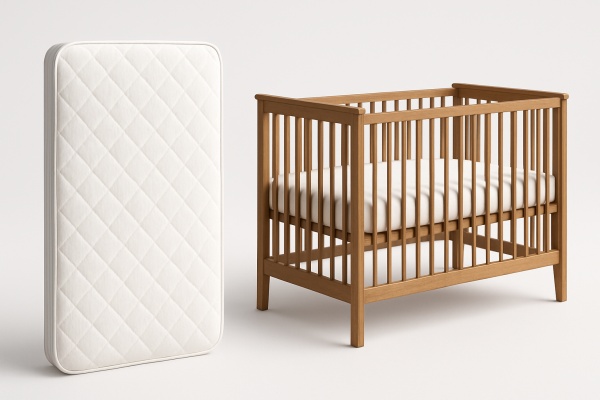
Think of the mattress as the foundation of your baby’s safe sleep space. While the crib provides the structure, the mattress is what your baby will actually sleep on. Getting this right is all about two things: firmness and fit.
Your Mattress Safety Checklist:
✅ FIRMNESS: It passes the “hand test”: Press the center and corners with your hand. The surface should spring back quickly rather than forming an impression. Avoid anything overly soft or cushioned — a firm mattress keeps your baby’s airway clear and supports healthy alignment.
✅ FIT: It passes the “two-finger rule”: Slide two fingers between the mattress and the crib frame; if they don’t fit, the size is right. Gaps can trap tiny arms, legs, or even a head, so the mattress should sit flush on all sides.
✅ COVERING: It’s simple and secure: Use a mattress made specifically for cribs. Pads, couch cushions, or makeshift bedding don’t provide the stability or safety that a dedicated crib mattress offers. Test the corners to ensure the mattress stays flat and doesn’t lift when pressed.
What Goes IN the Crib? (The Bare Necessities)
When it comes to setting up your baby’s crib, there’s a powerful mantra to live by: Bare is Best. It’s natural to want to create a soft, cozy nest for your little one, but the safest crib is a minimalist one. Clutter-free is the way to be for safe sleep. Let’s break down exactly what is and isn’t needed inside the sleep space.
Your “In the Crib” Safety Checklist:
✅ THE BABY. Place your baby on their back for every sleep time, naps, and nighttime.
✅ A FIRM, FLAT MATTRESS that fits snugly in the crib frame.
✅ A TIGHT-FITTING CRIB SHEET. Use only a sheet specifically designed for your crib mattress to ensure it stays secure and won’t come loose.
❌ Pillows, Blankets, and Quilts: These soft items can block a baby’s nose or mouth.
❌ Crib Bumpers (of any kind): This includes padded and mesh bumpers. They are a hazard for suffocation, strangulation and can prevent proper air circulation around your baby.
❌ Stuffed Animals, Loveys, and Toys: As adorable as they are, they don’t belong in the sleep space until your child is much older (well after the first year).
❌ Sleep Positioners and Anti-Roll Products: These products often claim to keep a baby in place but are associated with a risk of suffocation.
❌ Loose Bedding: This includes any extra sheets, blankets, or nursing covers draped over the side.
It might look a little sparse to our adult eyes, but to your baby, this simple, clear space is the ultimate safe haven. By keeping the crib bare, you are removing all potential hazards and giving your little one a clear, safe runway for dreamland.
How Should Baby Be Dressed for Safe Sleep?
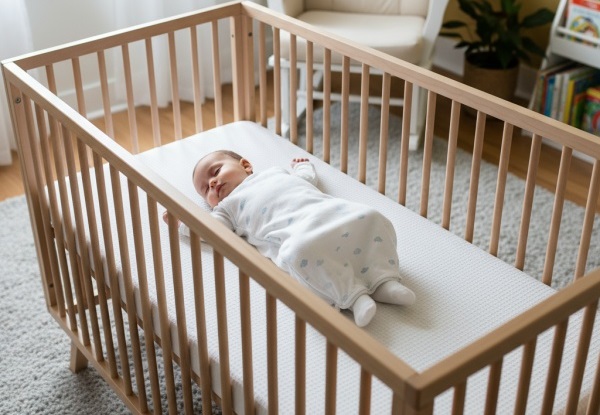
Now that we’ve established the crib itself should be bare, a common and very important question arises: “How do I keep my baby warm without blankets?” This is where your cleverness as a parent comes in! The solution is all about dressing your baby correctly for bed.
The goal is to choose clothing that will keep them comfortably warm without posing any risk of covering their face or overheating.
Your Safe Sleep Attire Checklist:
✅ OPT FOR A WEARABLE BLANKET (SLEEP SACK): A wearable blanket is a sleeveless, bag-like garment that zips or snaps up the front. It keeps your baby’s core warm while leaving their arms free and ensuring their face is never covered.
✅ DRESS IN LAYERS: The “One More Layer” Guideline: A good rule of thumb is to dress your baby in no more than one extra layer than you would wear to be comfortable in that same room.
✅ CHECK FOR OVERHEATING: The “Chest Test”: Instead of feeling their hands or feet (which are often cooler), feel the back of their neck or their chest. If their skin is warm and dry, they’re perfectly comfortable. If it feels damp or sweaty, they are too hot.
✅ AVOID HATS ONCE YOU’RE INDOORS: While a hat is essential for a newborn right after birth to prevent heat loss, it should be removed once you are in a stable indoor temperature.
✅ KEEP IT SIMPLE: Avoid Cords, Strings, and Hoods: Steer clear of pajamas with ties or cords, and avoid putting your baby to sleep in outfits with hoods. These can present a strangulation hazard.
Where is the Safest Place to Put the Crib in the Room?
You’ve chosen the perfect crib and mattress and know exactly what goes inside it. Now, let’s talk about where it goes. Think of it as scouting the perfect spot for your baby’s command center—a place that is safe, practical, and peaceful.
Your Crib Placement Safety Checklist:
✅ AWAY FROM WINDOWS: Place it at least a few feet from windows, blinds, and curtain cords to prevent entanglement or drafts. This also keeps your baby safe from direct sunlight that could cause overheating.
✅ AWAY FROM WALL HANGINGS & SHELVES: Ensure the crib is not directly below any heavy wall art, shelves, mirrors, or decorative items.
✅ AWAY FROM CORDS: Keep the crib at least three feet away from any cords. This includes cords from window blinds, baby monitors, video cameras, or electrical appliances.
✅ AWAY FROM HEAT SOURCES & VENTS: Avoid placing the crib directly next to a radiator, space heater, heating vent, or air conditioning unit.
✅ AGAINST AN INTERIOR WALL (IF POSSIBLE): An interior wall (a wall that doesn’t face the outside of the house) is often the most temperature-stable and quietest spot in the room, free from drafts and external noises.
✅ WITH CLEAR VISIBILITY: If possible, position the crib so you can easily see your baby from the door.
Assembly and Maintenance: Are You Checking Regularly?

A crib is a dynamic piece of furniture; as your baby grows and becomes more active, they’ll test its limits in ways you never imagined. Think of it like caring for a car: you wouldn’t drive for years without an oil change or tire check. The same diligence applies here.
Your Assembly & Maintenance Safety Checklist:
✅ FOLLOW INSTRUCTIONS METICULOUSLY DURING ASSEMBLY: If your crib is new, use only the hardware provided by the baby furniture manufacturer. If you’re using a second-hand crib, contact the manufacturer to obtain the correct instructions and hardware.
✅ PERFORM THE “WOBBLE TEST” MONTHLY: It should feel solid and not wobble excessively. If it does, something may be loose.
✅ TIGHTEN HARDWARE EVERY FEW MONTHS: Every two to three months, go around the crib with the provided tool (usually an Allen wrench) and tighten all screws, bolts, and brackets. Pay special attention to rail and mattress support hardware.
✅ CHECK FOR DAMAGE: Look for any signs of wear and tear, such as splinters, cracks in the wood or plastic, rough edges, or peeling paint.
✅ AVOID MAKESHIFT REPAIRS: Never use tape, rope, or hardware not designed for your specific crib model to fix a problem.
✅ KEEP THE INSTRUCTIONS & HARDWARE: Store the assembly manual and any extra hardware in a labeled envelope taped to the back of the crib or in a safe place you’ll remember.
✅ MANAGE TEETHING DAMAGE SAFELY: If your baby begins teething on the crib rail, avoid DIY solutions. Instead, use a manufacturer-approved teething guard that attaches securely and does not create a suffocation or entanglement hazard.
When is it Time to Lower the Mattress?
Watching your baby learn new skills is one of the most exciting parts of parenthood. But with each new milestone comes a need to reassess their environment—especially their crib. One of the most important adjustments you’ll make is lowering the mattress. Think of it this way: your baby’s mobility will change dramatically in the first year, and the crib needs to change with them. Staying one step ahead is the best strategy.
Your Mattress Height Safety Checklist:
⬇️ START AT THE HIGHEST LEVEL: For a newborn, the mattress is typically at its highest position. This makes it easy for you to lift your baby in and out without straining your back.
⬇️ LOWER TO THE MIDDLE HEIGHT: When your baby can sit up on their own.
The moment your baby can push up onto their hands and knees or pull themselves into a sitting position without your help, it’s time to lower the mattress. Lowering it now prevents a fall from a dangerous height.
⬇️ LOWER TO THE LOWEST HEIGHT: When your baby can stand on their own.
The very day you see your baby pull themselves up to a standing position—whether in the crib or elsewhere—is the day you need to move the mattress to its very lowest setting. A baby who can stand can also topple over the rail if the mattress is too high.
⬇️ TIME FOR A TODDLER BED: When height is no longer a barrier.
Eventually, your child’s height and agility will make the crib itself a risk, no matter how low the mattress is. It’s time to transition to a toddler bed or a low bed on the floor when:
- Your child reaches 35 inches in height, OR
- They demonstrate they can climb over or attempt to climb out of the crib.
Conclusion
Creating a safe sleep space for your baby is one of the most profound acts of care you can offer in these early days. While the guidelines might have seemed detailed at first, we hope this checklist has transformed them from a source of worry into a straightforward plan of action.
Remember, the goal wasn’t to memorize every rule, but to embrace a simple philosophy: bare is best. A firm mattress, a fitted sheet, and your beautifully dressed baby are all that’s needed for a safe and restful night. Everything else—from where you place the crib to how you maintain it—is about protecting that simple, secure space.
Recommended Related Articles:
- What to Do if a Toddler Climbs Out of the Crib?
- Mini Crib Vs Crib: Which Is Best for Your Baby?
- Crib Recalls 2025: What Parents Need to Know
- What Is a Convertible Crib?
- How to Choose a Crib for Your Child?
- Top 10 Crib Manufacturers in Australia
- Top 10 Crib Manufacturers in China
- Top 10 Baby Cot Manufacturers in Malaysia


